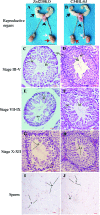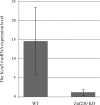Targeted disruption of the mouse testis-enriched gene Znf230 does not affect spermatogenesis or fertility
- PMID: 25505846
- PMCID: PMC4261971
- DOI: 10.1590/S1415-47572014005000013
Targeted disruption of the mouse testis-enriched gene Znf230 does not affect spermatogenesis or fertility
Abstract
The mouse testis-enriched Znf230 gene, which encodes a type of RING finger protein, is present primarily in the nuclei of spermatogonia, the acrosome and the tail of spermatozoa. To investigate the role of Znf230 in spermatogenesis, we generated Znf230-deficient mice by disrupting Znf230 exon-5 and exon-6 using homologous recombination. The homozygous Znf230-knockout (KO) mice did not exhibit Znf230 mRNA expression and Znf230 protein production. Znf230 KO mice exhibited no obvious impairment in body growth or fertility. Male Znf230 KO mice had integral reproductive systems and mature sperm that were regular in number and shape. The developmental stages of male germ cells of Znf230 KO mice were also normal. We further examined variations in the transcriptomes of testicular tissue between Znf230 KO and wild-type mice through microarray analysis. The results showed that the mRNA level of one unclassified transcript 4921513I08Rik was increased and that the mRNA levels of three other transcripts, i.e., 4930448A20Rik, 4931431B13Rik and potassium channel tetramerisation domain containing 14(Kctd14), were reduced more than two-fold in Znf230 KO mice compared with wild-type mice. Using our current examination techniques, these findings suggested that Znf230 deficiency in mice may not affect growth, fertility or spermatogenesis.
Keywords: Kctd14; Znf230; knockout mice; spermatogenesis.
Figures




Similar articles
-
Expression and localization of the spermatogenesis-related gene, Znf230, in mouse testis and spermatozoa during postnatal development.BMB Rep. 2008 Sep 30;41(9):664-9. doi: 10.5483/bmbrep.2008.41.9.664. BMB Rep. 2008. PMID: 18823591
-
A new mutant transcript generated in Znf230 exon 2 knockout mice reveals a potential exon structure in the targeting vector sequence.Acta Biochim Biophys Sin (Shanghai). 2013 Feb;45(2):123-8. doi: 10.1093/abbs/gms101. Epub 2012 Nov 28. Acta Biochim Biophys Sin (Shanghai). 2013. PMID: 23196134
-
The shorter zinc finger protein ZNF230 gene message is transcribed in fertile male testes and may be related to human spermatogenesis.Biochem J. 2001 Nov 1;359(Pt 3):721-7. doi: 10.1042/0264-6021:3590721. Biochem J. 2001. PMID: 11672448 Free PMC article.
-
Molecular cloning and characterization of a mouse spermatogenesis-related ring finger gene znf230.Biochem Biophys Res Commun. 2003 Jun 27;306(2):347-53. doi: 10.1016/s0006-291x(03)00970-7. Biochem Biophys Res Commun. 2003. PMID: 12804569
-
Testis-specific peroxiredoxin 4 variant is not absolutely required for spermatogenesis and fertility in mice.Sci Rep. 2020 Oct 21;10(1):17934. doi: 10.1038/s41598-020-74667-9. Sci Rep. 2020. PMID: 33087733 Free PMC article.
Cited by
-
MAFB is dispensable for the fetal testis morphogenesis and the maintenance of spermatogenesis in adult mice.PLoS One. 2018 Jan 11;13(1):e0190800. doi: 10.1371/journal.pone.0190800. eCollection 2018. PLoS One. 2018. PMID: 29324782 Free PMC article.
-
Safety of high-dose Puerariae Lobatae Radix in adolescent rats based on metabolomics.Food Sci Nutr. 2020 Dec 1;9(2):794-810. doi: 10.1002/fsn3.2044. eCollection 2021 Feb. Food Sci Nutr. 2020. PMID: 33598164 Free PMC article.
References
-
- Borden KLB. RING domains: master builders of molecular scaffolds? J Mol Biol. 2000;295:1103–1112. - PubMed
-
- Cao-Ehlker X, Zong X, Hammelmann V, Gruner C, Fenske S, Michalakis S, Wahl-Schott C, Biel M. Up-regulation of hyperpolarization-activated cyclic nucleotide-gated channel 3 (HCN3) by specific interaction with K+ channel tetramerization domain-containing protein 3 (KCTD3) J Biol Chem. 2013;288:7580–7589. - PMC - PubMed
-
- Fantz DA, Hatfield WR, Horvath G, Kistler MK, Kistler WS. Mice with a targeted disruption of the H1t gene are fertile and undergo normal changes in structural chromosomal proteins during spermiogenesis. Biol Reprod. 2001;64:425–431. - PubMed
LinkOut - more resources
Full Text Sources
Other Literature Sources
Research Materials

